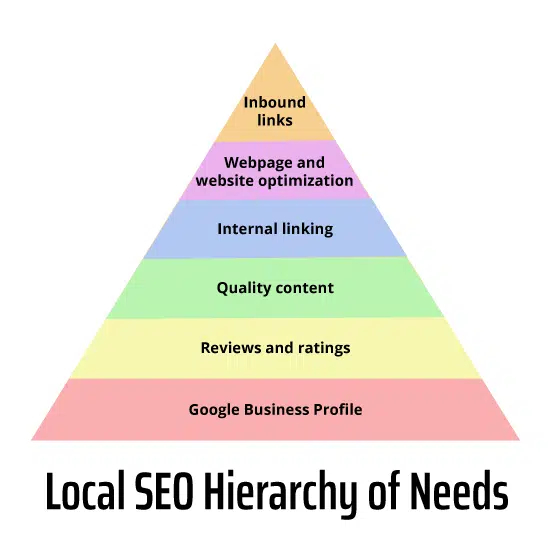In today’s highly competitive online environment, it’s essential for local businesses to optimize their online presence. With the right search engine optimization (SEO) tactics, local businesses can gain more visibility, attract more customers, and increase revenue.
Seven of the most important SEO tactics that every local business should do at a minimum.
- Google Business Profile: Creating, verifying, and optimizing a Google Business Profile is one of the most critical tactics for ranking local businesses in the Local Pack. The Local Pack is a group of three local business listings that appear at the top of the search engine results page (SERP) when users search for a local business.
To optimize your Google Business Profile, consider the following:
- Choose the most relevant primary category for the business, then add two to three categories that are most relevant. The primary category is the most important factor in helping to rank in the local pack. Use a tool like PlePler to find the best category for your business.
- Fill in the Google Business Profile as completely as possible. Provide a compelling description of your business and its offerings, using rich keywords as often as possible in a natural way.
- Ensure the business name, address, phone, and website (NAP+W) are accurate. A physical address will be a key signal to Google for ranking, as it looks at businesses closest to the point of search (where the searcher is). The NAP+W data must be consistent across all sources online – not just a Google Business Profile – because it improves the search engine’s confidence in a business listing’s accuracy. Use a local phone number (not a toll-free one).
Please check our SEO Packages

- Ratings and Reviews: A local business’s ratings and reviews can impact how well it ranks, including how many reviews (text-based and numerical star ratings) and the actual scores. To optimize your ratings and reviews, consider the following:
- Encourage customers to leave reviews. Share a link with customers to leave reviews on an ongoing basis to ensure the recency of reviews, which can be a positive signal to Google.
- Don’t offer incentives for leaving reviews. While many local businesses do this, it’s not recommended because it can create an inaccurate picture of the business.
- Read and reply to reviews. Show customers that you value their feedback by reading and responding to their reviews.
- Consider displaying third-party reviews to add value to the listing. This can further help users decide on a business.
- Quality Content: Quality content is one of the most important on-page ranking factors for organic rankings. To ensure quality content on your site, consider the following:
- Study Google’s search quality rater guidelines, specifically the definitions of “experience” and “expertise” to understand how Google thinks of quality content.
- Ensure that your content is well-written and offers value to your audience. Use long-tail keywords naturally in your content.
- Use heading tags (H1, H2, H3) to organize your content.
- Incorporate images and videos to break up the text and add visual interest.
- Backlinks: Backlinks are links from other websites that point to your website. Backlinks are a key ranking factor for organic search rankings. To get backlinks, consider the following:
- Offer valuable content on your website that other websites will want to link to.
- Reach out to local bloggers or journalists and offer to be a source for their stories.
- Attend local events and network with other businesses to get links from their websites.
- Mobile Optimization: More and more users are accessing the internet on mobile devices, so it’s essential to have a mobile-optimized website.
- Local keywords: Including local keywords on a site is essential for local businesses to rank in Google’s organic listings. These keywords should be included in the website’s title tags, meta descriptions, header tags (H1, H2, H3), and content (including alt tags on images). It’s important not to overuse the keywords or force them into unnatural language. Instead, include them in a way that reads naturally and provides context to the user.
Here are some examples of local keywords:
City or town names
Neighborhoods
Landmarks or popular locations
Local area codes or phone numbers
Slang terms or nicknames for the area
7. Google My Business posts
Google My Business (GMB) posts are a newer feature that allows businesses to share news, promotions, events, and other updates on their Business profiles.
Please check our SEO Packages
Here are some tips for GMB posts:
Use high-quality images or videos to catch the user’s eye
Include relevant keywords in the post’s content
Add a call-to-action (CTA) button to encourage users to take action
Post regularly to keep the profile fresh and up-to-date
Optimizing a local business for search engines can be a daunting task, but implementing these six SEO tactics can be a great place to start. By creating and optimizing a Google Business Profile, focusing on ratings and reviews, including local keywords on a site, posting on Google My Business, and building backlinks, local businesses can start to improve their visibility in both the local pack and organic listings.
Frequently Asked Questions
Q: How long does it take to see results from these tactics?
A: It can take some time to see results from SEO tactics, but implementing these strategies can help improve a local business’s visibility over time.
Q: Are there any risks involved in using these tactics?
A: While these tactics are generally safe, it’s important to avoid any black-hat SEO practices that could result in a penalty from Google.
Q: Can these tactics be applied to any type of local business?
A: Yes, these tactics can be applied to any type of local business looking to improve their search engine visibility.
Sharing is Caring!
